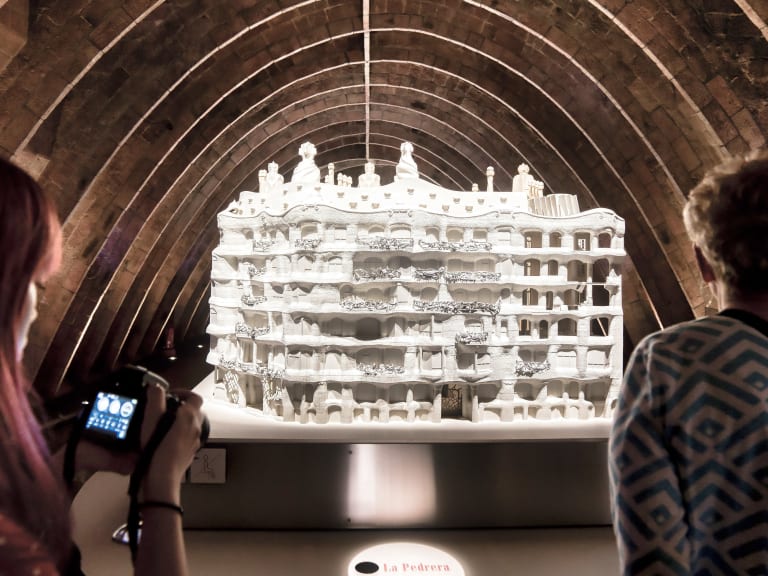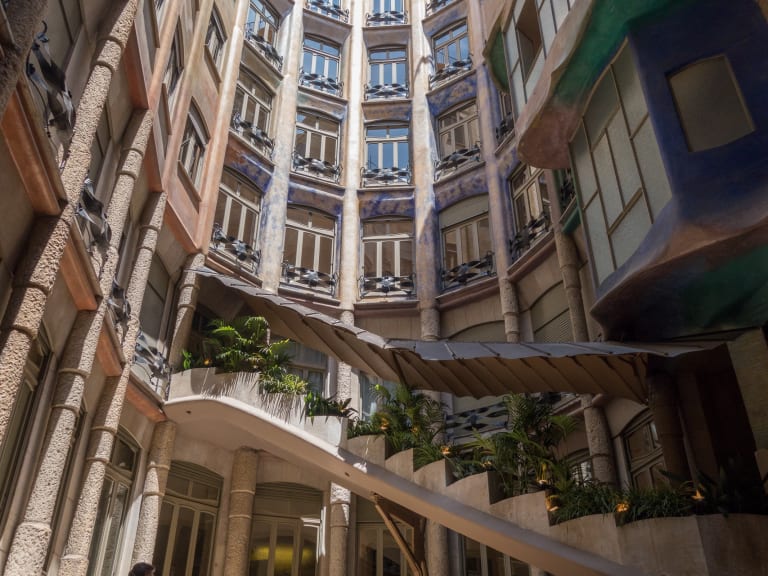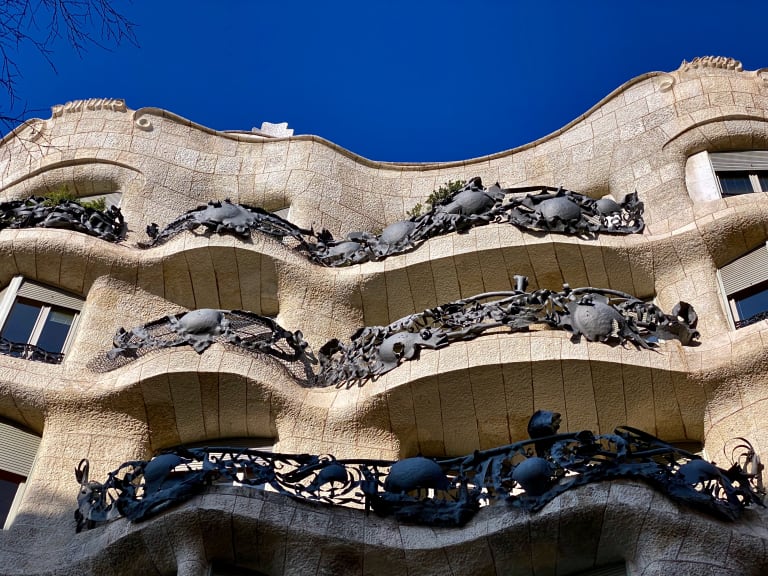More about: Things You Can´t Miss at La Pedrera Barcelona
Considered by experts to be Antonio Gaudí's most emblematic civil architecture building, a tour inside this important work is vital to understand the evolution of the important architect from Barcelona, as well as the best things to do in Barcelona.
Gaudí built La Casa Milà (the building's real name) at the age of 57 between 1906 and 1912, the last work he managed to complete before his death. Works such as La Sagrada Família were left unfinished after his death.
So, if you've already got your tickets to La Pedrera, you're probably wondering: What's so wonderful about this building? What should you pay attention to when you decide to visit it? Below I'll give you all the details of what is possibly my favourite work in the whole city, and I hope you enjoy it!
1. The Entrance Lobbies

Casa Milà is located on a corner plot, so it has two main entrances, one on Paseo de la Gracia street and the other directly on the characteristic chamfer formed by the corners of the streets of Barcelona. The foyers are spacious and full of light thanks to the presence of windows, an iron and glass main door and, above all, the light that floods in from the interior courtyards.
The two foyers of La Pedrera act as a connection point for all the rooms in the complex. The majestic staircases connect directly with the main floor, which was originally designed as the home of the owners, the Milá family. The connection to the rest of the flats and the roof terrace is achieved by means of the lifts. Gaudí conceived the lift as the main element of vertical communication, placing additional stairs mainly for service use.
2. The crown of the building: the roof terraces

The roof terrace of the Casa Milà is like nothing you've ever seen before. Here Gaudí conceived an open space straight out of a fantasy novel. The Spanish poet Pere Gimferrer described this place as "the garden of warriors" because of the 28 chimneys, whose curved shapes are nothing like conventional chimneys but rather resemble imposing masked warriors.
On the rooftop, the undulating floors give way to steps and unevenness, so during the tour I recommend paying close attention to your feet, although this is difficult because everywhere you look you will come across sculptural and architectural details that will captivate your attention.
In addition to the winding paths, thousands of pieces of broken marble and tiles from Valencia are used to cover several of the chimney sculptures because at night the rooftop is spectacularly illuminated by the lights on the roof.
As if all this wasn't enough, the fabulous terrace offers some of the best views of Barcelona.
3. The whale's attic and the Gaudí exhibition

Many people might wonder whether or not it is interesting to visit the attic of a building, but when talking about a Gaudí building the answer will always be yes. Christened the attic of the whale, in Gaudí's initial plan this space was conceived to house the service and laundry rooms of the building. However, a service area is not synonymous with a relegated or second-rate space, quite the opposite.
Today the attic space is used as a museum, so in addition to admiring the structure, you can enjoy the Espai Gaudí collection devotedentirely to the architect's work. Here you can find dozens of models and plans of his most famous works as well as spectacular plaster models made to scale to study the façade and structure of the Casa Milà.
4. The courtyard system and its conceptual load

The system of interior courtyards created by Gaudí served as a rather ingenious architectural solution that helped to solve the problem of ventilation and lighting in the blocks of free-standing buildings. Two interior courtyards, one smaller and one larger, rise from the ground floor level directly to the roof. Entering these spaces and looking up to the sky is a delight to the senses; let's take a look at the qualities of each.
The courtyard of flowers
The main and decidedly peculiar feature of the Patio de las Flores is undoubtedly its use of colour. This space is accessed through the entrance hall facing Paseo de Gracia street.
If you come from outside you will quickly notice that a play of shapes, colours and lights offers a spectacle that clearly contrasts with the chromatic sobriety that characterises the façade of La Casa Milà. The Patio de las Flores has a floor plan of 90 metres, making it the smaller of the two.
The courtyard of butterflies
The Butterfly Courtyard, on the other hand, speaks of nature and life in movement, which is its most outstanding quality. The structure itself is made up of numerous sculptural forms that evoke creatures of nature: an immense butterfly perched on the entrance threshold or a large wing of some insect of impossible dimensions envelops the staircase leading up to the main floor. The butterfly courtyard is the larger and more imposing of the two, with its 150 m2, and is located behind the entrance hall that connects to the Rue Provenca.
5. The basement, an unprecedented innovation!

Following a similar pattern of organic forms, Gaudí conceived this space as a garage, where the carriages and automobiles that the owner of the project was already fond of could be stored. Access to the basement is via the two main vestibules by means of helicoidal ramps, and this space is currently used as an auditorium.
Leaving aside the curved forms, the basement of the stone quarry may seem to us in modern times to be a common spatial solution in a residential building. However, it is vitally important to understand the historical context in which this project was built. In 1912 there was no similar solution anywhere in the world, the need to dedicate a space for the storage of a vehicle was not conceivable; this only made it clear over the years how far ahead of its time Gaudí's work and ingenuity were able to reflect on the needs of modern life and take precedence over them.
6. The structural system and the use of materials

On your tour of La Pedrera always try to pay attention to the structural solutions that Gaudí offered to the different construction problems. From stone, brick or iron pillars, he did not skimp on the use of materials that allowed him to provide the best possible solution in each scenario.
On your tour you will notice that the interior layout of the different rooms is characterised by a free geometry. The absence of load-bearing walls results in interchangeable spaces that can be adapted to the needs of the tenant. The optimisation of the façade as a structural system makes it possible to distribute the loads without overloading the interior spaces.
In the attic or loft area Gaudí used all his ingenuity to create a framework of 270 parabolic brick arches whose strength serves to support the roof terrace just above.
7. The floor of the neighbours and the custom-made furniture

The fourth floor of the building houses what is known as "The Neighbours' Apartment"; the only flat in the entire building whose design and furnishings to this day (more than 100 years later) remain exactly as Gaudí designed them.
Pere Milà and his family lived in this flat for decades. The interior remains in an impressive state of preservation so that a tour of its rooms is akin to a journey back in time in which you can appreciate the way the upper class of Barcelona lived at the beginning of the last century. It is disturbing and wonderful to see how, despite the passage of time, even the children's toys seem to have been frozen in time.
During your visit, pay special attention to the custom-made furniture designed by Gaudí; authentic pieces of art from the modernist movement.
8. The entrance doors

Access to the foyers of Casa Milà is through wrought-iron gates whose appearance only serves to emphasise the unique language of Gaudí's work. This same style was followed in all the balconies that interact with the main façade and other balustrades inside the building.
Their organic design evokes natural forms, from butterfly wings to turtle shells; the combination of materials such as iron and glass serves several purposes: firstly as an element of protection from the exterior and secondly as a natural lighting resource that allows the lobby space to be bathed in light.
9. The paintings and murals

Inside the Casa Milà it is possible to find some artistic works typical of the modernist movements popular at the time. This intention can be seen in the foyers, where you can enjoy the work of the artist Aleix Clapés. His work for Gaudí's work follows themes of mythological inspiration and although it has undergone several restorations it is still fabulously preserved. Pay special attention to the murals on the staircases that connect the entrance floor with the main floor of the building.
It is important to understand that Gaudí's architecture did not seek excessive adornment of the walls through conventional plastic works such as paintings; Gaudí preferred the integration of art directly into the form with the combination and use of different materials in order to express his creative language.
10. The façade is a faithful example of Gaudí's style

Whether you are leaving or arriving at the building, it is mandatory that you take a moment to analyse the most eye-catching, singular and striking element of the whole building: its imposing façade. The façade, which is made entirely of stone and has undulating forms, made it a highly controversial design for the time and aroused the displeasure of many of its contemporaries. The nickname La Pedrera was born precisely from the mockery of those who at the time considered it an ugly and unpleasant building.
The Casa Milà is considered an innovative work mainly because of its all-steel structure and the use of curtain walls, especially on its self-supporting façade. In addition to the use of undulating stone to create unique organic forms, wrought iron is used in the imposing entrance doors (which also use glass), in the balusters of the balconies and in the windows that open directly onto the streets.
This was the last work of a civil nature that the architect built before focusing entirely on the design and construction of the Sagrada Família, so that in La Pedrera we can see the full maturity of his peculiar style. Gaudí manages to leave us with an artificial building that beautifully imitates nature.




